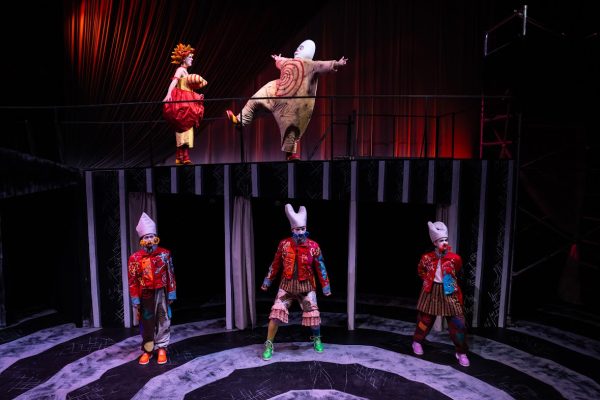On a December night at the dawn of the twentieth century, there was a small commotion in Paris. As curtains went down on what would happen to be both the opening and closing night of Alfred Jarry’s play, “Ubu Roi,” a riot broke out in the theater. Crude, grotesque and downright bizarre though it is — and perhaps because of it being so — “Ubu Roi” shook the theater world to its foundations, allowing movements like surrealism, modernism and absurdism to emerge through the cracks.
On a November afternoon in 2023, I walked into a rehearsal of the Tulane University Department of Theatre and Dance production of the play. Oddities revealed themselves to me gradually, then all at once. First, there were the suspiciously stained toilet brushes dangling above the theater’s entrance. Then there were the lightbulbs hung above the seats, which were plugged into plungers. Before long, there was an actor bouncing about the stage in what appeared to be an inflated potato sack, an egg-shaped helmet strapped to her head. This was the star of the show, the king Pa Ubu.

I overheard the show’s director, professor Antony Sandoval, tell the group of actors during his notes that what they were doing was not acting, but “driving a bus.” Correspondingly, what you will see here is probably like no play you have seen before. It comes from familiar sources, though: “Ubu Roi” is something of a mash-up of Shakespeare’s Macbeth, Hamlet, Richard III and The Winter’s Tale, the last insofar as there is a pursuit by a bear.
Put briefly, the premise is that a king named Pa Ubu is convinced by his queen, Ma Ubu, to kill the king of Poland and establish a reign of terror. His child-like narcissism and greed soon spirals out of control, and his former allies turn against him in a riotous climax.
Though a barrage of dialogue runs throughout the play, it is not through language that the story is told. Here, words lose their individual shape, deformed almost into mere noise by the force of their utterance: they become physical tools, each with the brute capacity to push things into motion. A case in point: the infamous opening line of the show is the expletive “sh*t,” and the term is used an accurately adolescent number of times over the course of the show. Generally, the motto of this production in particular seems to be “when in doubt, be louder.”
But loudness is not restricted to what can be heard. Visually — and physically, on the part of the performers — the show reaches almost dangerous levels. Despite the show’s tendency to teeter on the precipice of chaos, it is unified as a piece of tight choreography, a series of rapid pushes and pulls between the actors that recalls both Italian commedia dell’arte and Japanese theater traditions in its dynamics. The play is in fact so immature that it is stripped down to the basic laws of comedic physics: slapstick, clownish gestures and grotesquely heightened facial expressions.
I like to think that Sandoval’s own French origins give him a privileged understanding of the play; the French, after all, have the most experience with the avant-garde. There is something deeply foreign about “Ubu Roi,” which American directors steeped in naturalistic and psychologically-inspired theatrical traditions would struggle to capture.
Apart from the circus-inspired aesthetic, Sandoval did not choose to impose a new concept on the production. Though the design elements of the production — the theses of design graduate students Ali Robinson, Kaylee Drake and Sammy Verdino — were inventive in themselves, they were not motivated by an inventive concept for the play as a whole. The all-female cast added an interesting new dynamic to the production, especially considering how the show plays with exaggerated gender stereotypes: Pa Ubu is bald and rotund, and Ma Ubu sports a pair of what one cast member justifiably referred to as “canons.”
The casting aside, it was a rather straight-ahead production of the play as far as I could tell, which is no knock against it. Since the play is mostly unknown to American audiences, I appreciated the opportunity to view it without the lens of an original production concept placed over it.
For the actors, going beyond the normal was impossible. Every element of the show required departing from habitual modes of behavior and returning to unbridled id. Pa and Ma Ubu, played by Sydney Schneider and Kaylee Postoak respectively; as well as the avenger Bougrelas, played by Sofia Severson, gave particularly impressive performances. Fully embodied in their characters, they captured Jarry’s uniquely carnivalesque mode and, as evidenced by Sandoval’s laughter from the seats, were comfortable trying the limits of their expressive capacity.
Running just 45 minutes, the show is a brief entropic burst on Tulane’s campus. In viewing it — because making sense of it isn’t entirely possible — the audience has no choice but to submit themselves to the swirl that is the play’s action. But don’t be fooled: staring into the swirling abyss that is “Ubu Roi” is no passive endeavor. Like all great plays, it will also stare back into you, maybe revealing that the thrones you sit so proudly upon are, in fact, porcelain.
“Ubu Roi” runs from Tuesday, Nov. 7 to Sunday, Nov. 12, 2023 in the Lupin Theatre. Tickets can be purchased here.



